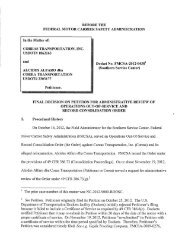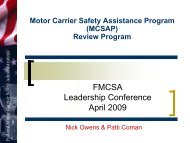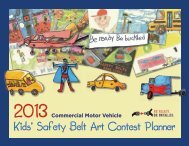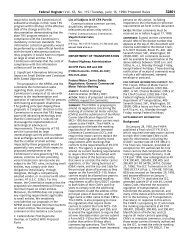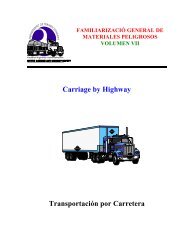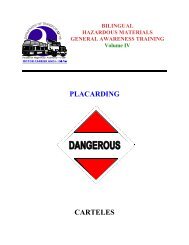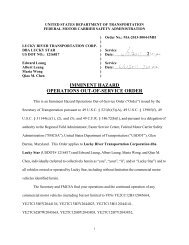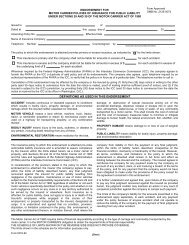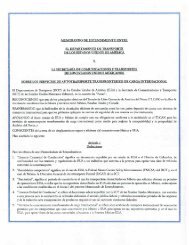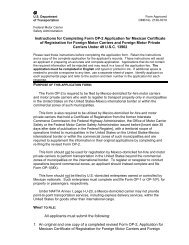office of analysis, research, and technology - Federal Motor Carrier ...
office of analysis, research, and technology - Federal Motor Carrier ...
office of analysis, research, and technology - Federal Motor Carrier ...
You also want an ePaper? Increase the reach of your titles
YUMPU automatically turns print PDFs into web optimized ePapers that Google loves.
IntelliDrive Safety Applications for Commercial Vehicles January 20, 2010<br />
Rick<br />
McDonough: I think the simple answer is yes. My underst<strong>and</strong>ing—<strong>and</strong> again, I am not an<br />
expert here—is that there are st<strong>and</strong>ards for certain message sets. Some <strong>of</strong><br />
those st<strong>and</strong>ards or scenarios could certainly use a modification or expansion is<br />
my underst<strong>and</strong>ing. Beyond that, I will probably get myself into trouble. I<br />
would say, the core foundation is there, but as we exp<strong>and</strong> applications <strong>and</strong><br />
potentials <strong>of</strong> this <strong>technology</strong>, there is probably additional work that needs to<br />
be done.<br />
Question: What is the Web site for ITS?<br />
Brian Cronin: It is www.its.dot.gov.<br />
Kirse Kelly: Once again, www.its.dot.gov.<br />
Jon Mueller: Are there any more questions, Jackie, on the phone?<br />
Question: Do you see V2I being implemented or online before V2V?<br />
Jon Mueller: Anyone can answer that I think, but the progress so far is that V2V is ahead <strong>of</strong><br />
V2I, but I do not think that there would be any intention to do one before the<br />
other.<br />
Rick<br />
McDonough: I think it depends on what you are exactly talking about, such as intersectioncrash<br />
avoidance which is really V2V <strong>and</strong> V2I. We are not there yet. If you are<br />
talking about just basic—what I will call passive information, probe<br />
information from the vehicle to the roadside to help with congestion mobility,<br />
traffic management, whatever, <strong>and</strong> then signage <strong>and</strong> incident information—<br />
essentially taking a variable message sign <strong>and</strong> sticking it inside the cockpit <strong>of</strong><br />
the vehicle—we are there. There is no doubt about it. We have shown it in<br />
Long Isl<strong>and</strong>. We have done it down in Greensboro. That is pretty simple<br />
pickings. The rest <strong>of</strong> it, the non-technical issues, there are some things that<br />
need to be addressed, <strong>and</strong> as we get into more sophisticated dynamic<br />
information, safety-critical information—scenarios such as crash avoidance<br />
between two vehicles—that is a longer way away <strong>and</strong> requires a lot more<br />
work on st<strong>and</strong>ards <strong>and</strong> policies, etc.<br />
Question: A few data link protocols were mentioned in the presentation—J1939,<br />
J1708. Will DOT decide which one will be used for this purpose?<br />
Jon Mueller: I don’t think the DOT is in a position to make a ruling on that. I think that is<br />
maybe an industry question. Technologies that exist, that provide benefit to<br />
this overall effort, I think, are the ones that will be involved. Again, I think it<br />
is primarily a vehicle OEM question. Anyone else care to comment?<br />
Alrik Svenson: That is the reason DOT cannot go at this alone. We have to be involved with<br />
the industry to determine the best solutions to all <strong>of</strong> these issues.<br />
25



